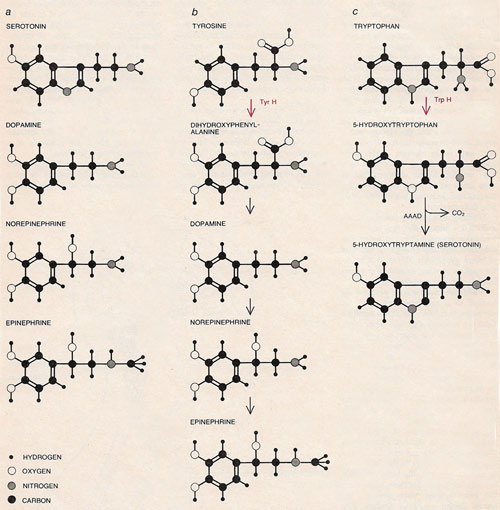neurotransmitter

Figure 1.The arrival of a nerve impulse stimulates the release of neurotransmitters from vesicles. They pass across the synapse and open channels in the target cell. Charged particles can then enter and trigger a second impulse.

Figure 2. Four neurotransmitters found in the brains of mammals (a, left) are serotonin, dopamine, norepinephrine (noradrenaline), and epinephrine (adrenaline). The precursor of serotonin is the amino acid tryptophan (c, right); the first step in the synthesis is catalyzed (colored arrow) by the enzyme tryptophan hydroxylase. An essential amino acid, tryptophan is available only in dietary protein. The other neurotransmitters (b, center) are formed in successive steps from the same precursor amino acid, tyrosine; the initial reaction (colored arrow) is catalyzed by the enzyme tyrosine hydroxylase. Not an essential amino acid, tyrosine can be synthesized in the liver of mammals.
A neurotransmitter is a chemical that mediates the transmission of a nerve impulse across the synapse between neurons and target cells. Neurotransmitters either stimulate or inhibit electrical impulses in target cells.
The neurotransmitter is released at the synaptic knob at the tip of an axon into the synaptic cleft. It diffuses across to the opposite membrane (the postsynaptic membrane), where it triggers the propagation of a nerve impulse in the next neuron (Figure 1).
More than 50 neurotransmitters have been identified (Figure 2). Important examples include adrenaline, also known as epinephrine, and noradrenaline, or norepinephrine, (in adrenergic nerves) and acetylcholine (in cholinergic nerves).


